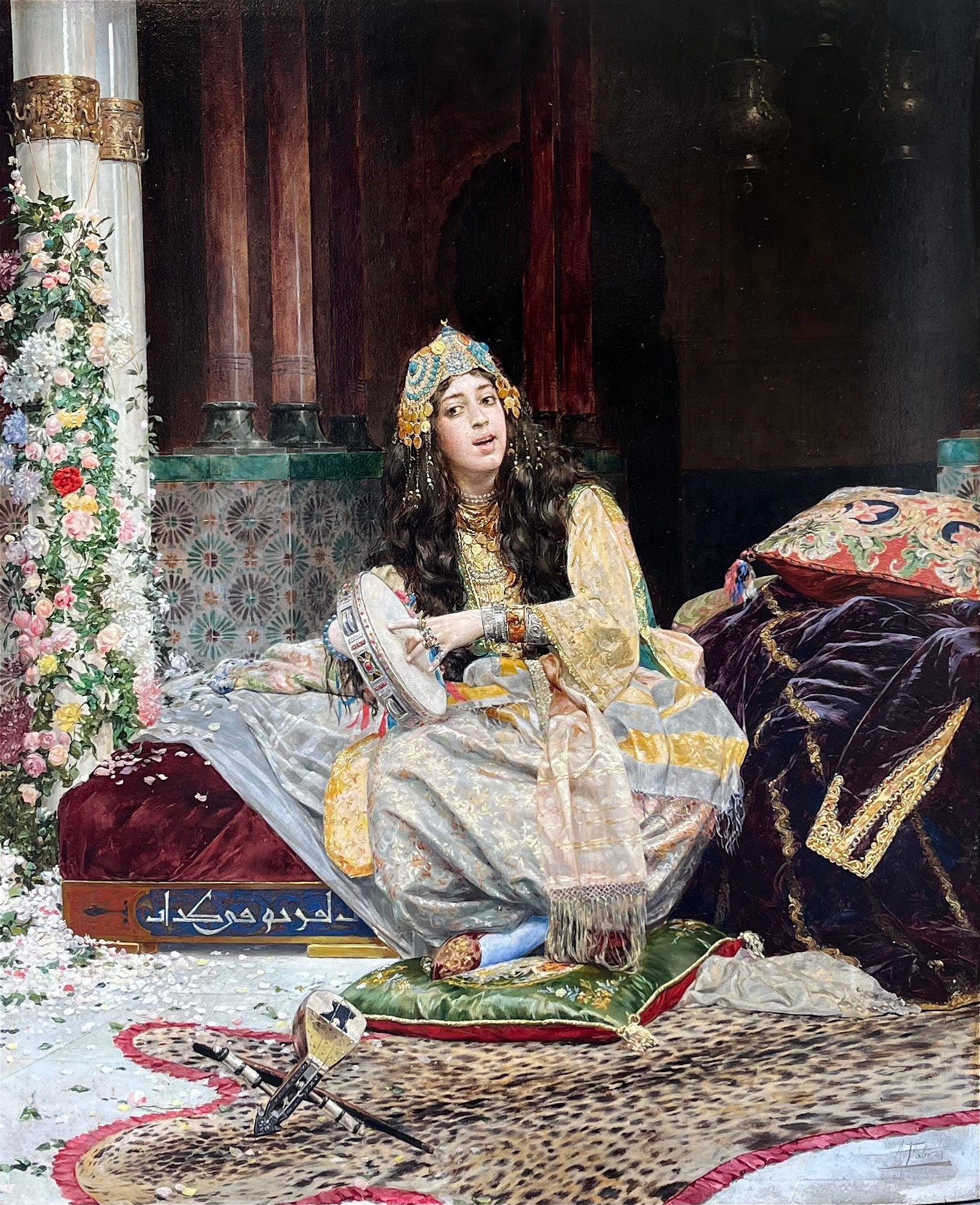

Antonio Maria Fabres y Costa
Harem Girl with a Tambourine
Oil on panel, signed lower right
Image Size: 21 ¾ x 18 inches (55.1 x 45.7 cm)
Framed
This painting exudes decadence and exoticism, marking it as a work that epitomises the Orientalist movement. It depicts a beautiful lady dressed in a kaftan and silken scarves - her fingers, wrists and neck are adorned with a variety of jewels, gold and silver, and she is also wearing a traditional coin headdress. This lady is evidently incredibly wealthy, further evidenced by the expensive fabrics that surround her on the daybed and the leopard skin rug on the floor - this plays into the Orientalist trope of wealthy and bejewelled Arabic and Maghrebi cultures. She is also culturally wealthy, as demonstrated by the dutar and tambourine, and the way her mouth is slightly ajar as if she is singing. Her surroundings depict traditional Middle Eastern architecture, such as silverware lamps, geometrically patterned tiles, and rounded archways. A beautiful display of fresh flowers snaked up a column in the left side of the image, adding a sense of gentle femininity to the work.
The painting is in Costa’s acclaimed realistic style, with attention paid to every last detail. No area of the image is lacking, from the individual leaves of the flowers, to the fabric patterns on the cushions, to the highly detailed calligraphic border on the daybed. The work is intended to appeal to the European market of the 19th century, which desired ‘realistic’ depictions of idealised and archetypal ‘exotic’ cultures from newly gained territories in the Middle East and North Africa.
Antonio Maria Fabres y Costa
Antonio Maria Fabred y Costa was born in Barcelona in 1854, the son of a drawing teacher. Costa was talented at drawing and his father began to tutor him. He spent some time in the studio of the sculptor Aleu i Teixidor and began to study sculpture at the Saint Jordi Academy in 1867. He won an award for a bust of one of his uncles, and eventually won a scholarship to study in Rome in 1875.
In Rome, Costa became acquainted with and heavily influenced by Mariano Fortuny and Jose Villegas. He turned away from sculpture as a medium and began to paint, becoming well known for his intense realism. His works were immensely popular with the upper classes, who appreciated his exotic and orientalist themes. This popularity enabled Costa to open a studio, which greatly increased his output and earned him international recognition.
During this time, Costa also became renowned for his watercolours, which he exhibited in Madrid in 1881 and 1882 to great commercial success. These watercolours were exhibited continuously throughout the 1880s, and were even given as a gift for Queen Maria Cristina and the Imperial Princess of Germany when they visited the Court. In 1886, Costa returned to Barcelona, and continued to exhibit watercolours in Madrid before expanding to Munich, where he won a Gold Medal in 1888.
After the death of his mother in 1894, Costa relocated to Paris and became acquainted with a number of orientalist artists. His fame grew exponentially with the help of dealer Goupil, who marketed Costa’s works as in direct succession to the immensely popular Fortuny. Costa began to exhibit at different salons around the world, winning an Honourable Mention at the Paris Salon in 1895, a Second Medal in 1896, and Silver Medals at the 1900 Universal Exhibition, the 1901 Salon and the 1902 Lyon Exhibition. During his time in France, Costa had formed a friendship with Mexican sculptor Jesus Contreras, who convinced him to become the head of the painting department at the Academy of San Carlos in Mexico City.
Costa relocated to Mexico in 1902, where he was both the head of the painting department and the deputy director of the Academy itself. He was also appointed Inspector General of Fine Arts Mexico by the President, and held responsibility for organising the capital’s museum. However, Costa often found himself at odds with the abstraction of the artistic scene in Mexico and returned to Rome in 1907 - his students later developed the Post-Revolutionary Movement, and many were muralists.
Returning to Europe, Costa continued exhibiting at Salons and Exhibitions globally, building a reputation in London, Vienna, Paris, Lyon, Barcelona, and even as far abroad as America. He participated in the 1910 Venice Biennale, as well as the commemoration for the 50th anniversary of Italian reunification. In 1916, he was commissioned by Pope Benedict XV to paint his portrait, which was later hung in the Vatican Museum. In 1925, Costa donated a number of his works to the Museum of Fine Arts in Barcelona in exchange for a hall in his name - the Museum took the works, but never built the hall. Costa was declared Commander of the Order of the Crown of Italy and became the honorary president of the Association of Watercolourists of Catalonia.
He died in Rome in 1938, leaving a legacy as a fierce orientalist whose methods and style inspired and influenced artists across the globe.

